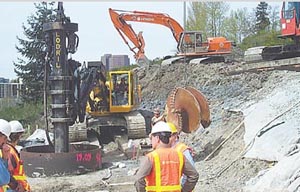
There also may be situations in which drilled shafts are not economically suited to a particular project. For example, where soft clays and/or loose, water-bearing sands to large depths are encountered, the resistance advantage and relative ease of construction afforded by driven piles or other alternates sometimes may make them more economical than drilled shafts. For small, single-span bridges in which the designer requires batter piles in the abutments, driven piles often are more economical than drilled shafts. However, in most other instances, drilled shafts are cost-competitive with driven piles when both systems are designed appropriately.
Construction
The attention to detail in the construction of drilled shafts is critical to ensure successful foundations. If proper and well-established procedures are employed, drilled shafts can be installed successfully in a wide variety of subsurface conditions with differing geometries and for a number of applications.Certain limitations exist with regard to the geometry of a drilled shaft. Diameters of 12 inches to 14 inches can be used if the length of the shaft is no more than perhaps 30 feet. The concrete may be placed by free fall in small-diameter shafts (as well as in shafts of larger diameter) if the mix is carefully designed to ensure that the excavation is filled and segregation is minimized. Such small foundations commonly are used to support sign structures and traffic barriers.
As the depth of the excavation becomes greater, the diameter normally must increase. Several factors that influence the ratio of depth to diameter: the nature of the soil profile, the position of the water table, whether or not a rebar cage is required, the design of the concrete mix and the need to support lateral loading. A concrete mix with a high workability (slump) frequently is required. Ordinarily, the aspect ratio of a drilled shaft, or its length divided by its diameter, should not exceed about 30.
Heavy, rotary-drilling equipment typically is used for large drilled-shaft excavations. Cylindrical holes can be drilled with diameters of up to 20 feet, to depths of 240 feet and with underreams up to 33 feet in diameter, although such sizes are unusual. Percussion equipment can make excavations of almost any depth with diameters up to 5 feet.
Versatile Solution
The versatility of drilled shafts is evident when the constructability is considered in various subsurface conditions. Situations that can be dealt with using readily available methods of construction:
- boulders above glacial till or rock (if the boulders cannot be broken or removed, the diameter of the drilled shaft excavation should be sized larger than the boulders)
- sockets into soft or hard rock
- residual soils where weathering is highly irregular
- karstic formations (solution cavities)
- caving soils below the water table
- very soft soils (permanent casing sometimes may be required)
- marine sites
ND
Report Abusive Comment